Content Production, Delivery, Viewing Can Be Targeted, Beautiful Or…
 There are two things SMPTE (Society of Motion Picture & Television Engineers) conference attendees like:
There are two things SMPTE (Society of Motion Picture & Television Engineers) conference attendees like:
- How to stay ahead of tech that’s breathing down their necks
- Standards
O.K., execs don’t like it when that technology seems to be disrupting almost every phase of their business; but the win is that if it allows them to produce stuff faster and more economically while capturing more eyeballs, well, they will embrace it.
Since consumers found OTT (over the top) viewing (what I want, when I want it, on the device I have right now); everyone is,rushing to meet the seemingly insatiable demand.

They try to figure out how to make money in the new environment because even the kids on YouTube, Facebook and Snapchat are racking up followers.
Build it and they will come only works in movies.
Now, they have something they never had before … information.
Yeah, tons and tons of information about who, where, how, when. Everything you ever wanted to know … and then some.
Jeezz, this big data thing is cool
Until it’s not!
The challenge is figuring out what is good data, what is garbage, what is noise.
SMPTE attendees were ultra-interested in analytics and AI (augmented intelligence) to help them potentially make money from all the storage racks of data they have back at the office.
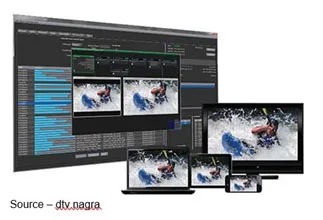
Content organizations (planners, producers, deliverers) wanted to learn how they could quickly and easily use their data to stay ahead of regulators/competition while delivering innovative revenue-generating services and capture and retain viewers everywhere.
No, I didn’t make a mistake.
I meant augmented, not artificial intelligence. Yes, the machine’s learning
I hate to tell Ginny, but IBM’s early releases of Watson, were cool but shall we say a bit early premie,
Machines just whirred around doing machine things.
It wasn’t until people started feeding the systems goals, guidelines and insights (augmenting their intelligence) that they started to put two and two together.
With the right parameters and objectives, the machines could sift through the piles of data, find the right data, associate that date and make “intelligent” decisions/recommendations.
When they were wrong, they could learn from the mistake and adjust. As they became more right, good things happened.
Unfortunately, too many firms invested heavily in AI technology and products, let them loose with the data but nothing good/better happened.
In some instances, big data/AI were a bit over promised.
Or, more frequently, management only heard the bullet point features and overlooked the small print – garbage in, garbage out.
You know, given a big enough pool of viewer information, aggressive analytics and super-cool AI, the technology can deliver tentpole after tentpole after tentpole results.
Sequels work until they don’t.
Series continue until something new, different comes along and viewing habits change.
Information isn’t the same as knowledge, knowledge isn’t the same as wisdom, and wisdom isn’t the same as action.
Sure, it requires an IT (information technology) infrastructure and IT talent but success also relies heavily on people who know policies, regulations and rights as well as the all-important, almost intuitive impact on customer expectations/demands.
Actually, attendees wanted to learn how to get and use the tools Netflix and Amazon have been honing to give them an edge with consumers.
It isn’t just a big stash of cash (sure, that helps) but attendees want to find out what is behind the curtain – stuff that could take advantage of experienced human inputs and guidance to improve their success scores and profits.
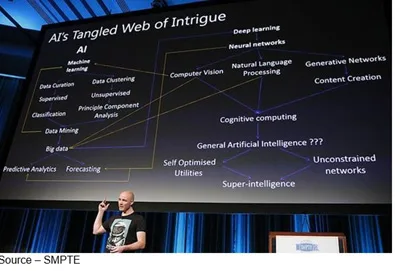
While M&E folks view AI with some degree of skepticism, SMPTE attendees packed the Predicting the Future session … just in case.
After all, data analytics and intelligent selection have proven to be pretty effective for Netflix, Amazon Prime, Hulu and a growing number of renegades.
They’ve shown that spot-on content, recommendations based on viewer activity and solid branding can capture and retain an audience.
This type of advanced media/customer intelligence adds significant value to them and their content production/delivery chains.
We’ll see what happens in 2019 when Disney launches its channel as Igor has said, “at a significantly lower price than Netflix.”
Mickey, Star Wars, Pixar, Marvel and the projects they’re working on will certainly draw an audience at the right price.
But, they’re not alone.
Every studio and network is launching their channel or figuring out how they can sell themselves to someone who wants to invest in tomorrow’s entertainment market.
The winners will be the ones that do the best job of blending human intelligence and ingenuity with increasingly refined information to develop/deliver the content and experiences people want–even when they don’t know what they want.
The key, according to Allan McLennan, president of PADEM Media Group, is for networks, channels and studios to use the new tools to enhance and balance creativity, ingenuity, compelling content and originality with standardization, scale, optimization and repetition.
“More succinctly,” he added, “The optimum balance of experience, instinct and accelerated execution.”
With an increasingly crowded and competitive market, content development and distribution organizations have to use all the tools available to them to hone their user experience identification capabilities.
“The viewer is clearly in the driver’s seat now,” McLennan observed. “Content providers, distributors and channels have to do everything possible to improve the discovery, personalization and loyalty to their content.”
Services that are slow to participate will release content in the wild that may be undiscovered, unwatched.
With the ever-growing library of video content out there, it means we’ll probably end up with four to five skinny bundles rather than one cable bundle with 1,000-plus channels we never knew!
C’est la vie
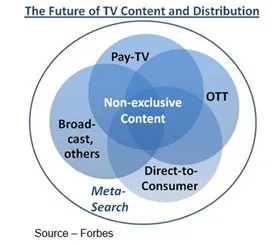
Studios, networks and swollen bundle provides see how Netflix and Amazon have used their data, analytics and recommendation tools and know they can do it better, without consorting with the enemy.
After all, the customers have spoken. They want choices, options, alternatives; and with OTT delivery, they can have their stuff … if they can find it.
So far, Netflix, Amazon, Hulu, Sky, iQiui, Viu, Tencent, pooq and a few others lead the pack in listening to, learning from visitors and serving up pretty close recommendations.
True YouTube, Facebook and Snapchat have the inside track on monetizing the pre-millennial Internet users, but their approach has been to throw enough content onto the Web and the stuff that sticks earns them money.
The rest?
Well hey, you tried!
SMPTE members including studios, networks, MVPDs (multichannel-video-programming distributors), know their options have broadened with the success of subscription-based, ad-free, video-on-demand services as viewers migrate to standalone streaming services such as HBO Now, CBS All Access, FubuTV, Reelgood, Sling TV, Kwese, ShowMax and thousands more.
But it’s the newest players – Netflix, Amazon Prime and others – that reap the biggest benefits because the content is their own and it’s unique, hence more valuable.
Skinny bundles of exclusive and non-exclusive content from distributors and creators are gaining in popularity as consumers find the more limited offerings (and lower prices) meet their needs.
And, you have to admit, a couple with 5-10 channels they actually watch at $15 each is a lot easier on the budget than the $75-plus cable bundle.
As for most people?
They like the free stuff!
Not the YouTube, Facebook free stuff but interesting, professionally produced free stuff that is supported by increasingly intelligent, sophisticated ads specifically for them.
Marketers are warming to the idea that rather than waiting for the Nielsen’s to come out to see how many million households they may have reached, they are able to reach an aggregate audience that more accurately fits their AI-suggested demographic/customer.
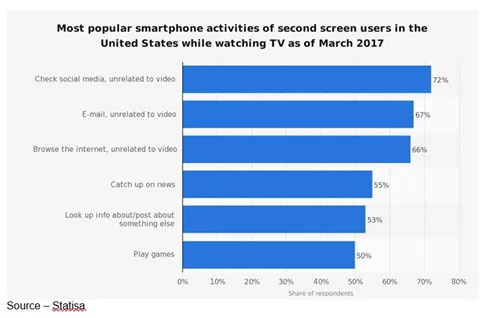
Sometimes, they even watch the ads; but usually, they pick up their phone to handle emails, texts and Facebook/LinkedIn.
Or, they may use the phone to go to the site and buy something … cool!
It sounds a little too logical, which is why the Amazon spokespersons responded to the ad-supported option rumor as “fake news.”
They’re already ramping up their offering for manufacturers to advertise on the Amazon site.
They can serve up a free viewing channel, add links directly to their site and BAM!
Think about it, Jeff.
It could give you a couple of billion to make more big purchases like The Lord of the Rings.
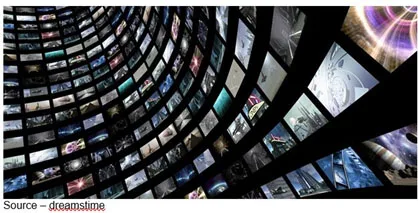
In addition, offering ad-supported content could open new opportunities for tens of thousands of great indie filmmakers.
Amazon’s highly intelligent search/match system could whiz through the huge content pool and serve up the content based on all the information people willingly give them.
It would also create an unprecedented opportunity for filmmakers to get what they work so hard for:
- money based on acceptance of their work
- exposure to potential audiences around the globe
Everyone gets what they want from the transaction.
Of course, SMPTE and other organizations have been working for quite some time to develop a standard that enables them to more efficiently, more effectively deliver high-quality, stutter-free content over the Internet.
Called ATSC (advanced television systems committee) 3.0, it’s a hybrid content delivery system that is already available in some countries and will roll out progressively in the U.S. over the next few years.
Its goal will be to deliver ultra-high definition (UHD) TV anywhere, anytime on any device.
The cool thing is it supports mobile, 3D viewing (O.K., it’s a hangover from a few years ago), 4K UHD, HDR (high dynamic range), HFR (high frame rate) and WCG (wide color gamut) quality and immersive audio.
SMPTE members including equipment manufacturers, content transport firms and consumer electronics technical people developed the standards that are scalable, interoperable, adaptable and (hopefully) able to handle future innovations.

McLennan said, “If you look at the complete ATSC 3.0 standard in a block diagram, it looks complicated. And it is.
“It isn’t just one standard but a suite of 20+ standards that work together to address specific and global content delivery issues,” he explained.
He agreed that the new standard does leave some older technologies behind, but it is a true IP-delivery streaming solution.
“In the same way an iPhone 8 or X isn’t compatible with analog cellphone protocols from the ‘90s, ATSC 3.0 isn’t compatible with 20-year-old ATSC 1.0 broadcast design,” he emphasized. “It’s an evolutionary, innovative and better solution for everyone in the category … including the consumer.”
He acknowledged that consumers will need upgrade somewhat with a new TV or set-top box to take advantage of all the new services – interactivity, VOD, OTT streaming, etc.
If not broadcasters will still support (simulcast) 1.0 streams.
McLennan noted that in South Korea and other countries where ATSC 3.0 service is already available, some people haven’t upgraded and still watch their programs.
“But once people see the streaming quality and experience the ease in receipt of new services/options, its believed the consumer will recognize the value,” he emphasized.
While some folks have raised the issue of privacy because more personal data will be collected, and ad targeting will be more prevalent, we see that as a consumer benefit rather than a problem.
People already provide sites, services with all their data.
And when it comes to selecting content, AI recommendation solutions hone in on what folks like, will probably like or should like.
Finally, free content can be surrounded by ads you find interesting instead of 20-somethings having to wonder WTF when they switch to their phone while hemorrhoid, fibromyalgia or worse ads fill the big screen.
It could mark the end of advertising mediocrity!
After all, the IAB (Interactive Advertising Bureau) recently found that OTT viewers spend twice the amount of time watching ad-supported content than subscription content.
Add the intelligent use of AI with great looking content and it could be a beautiful thing.

It’s not like this is your brain when AI delivers content to your screen.
You still have a choice!
# # #